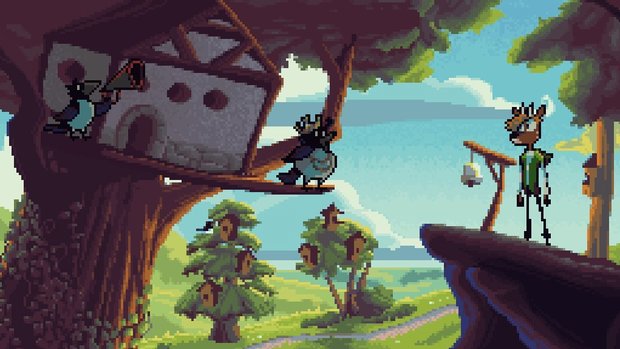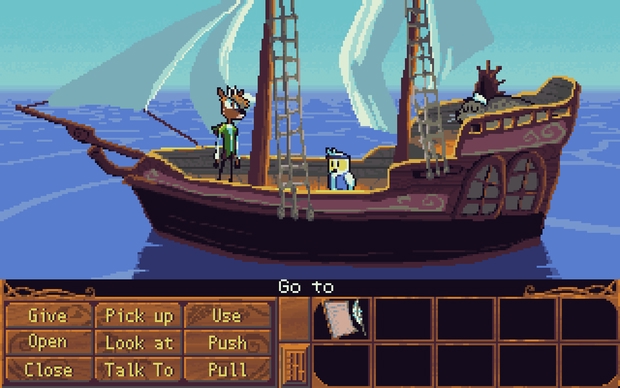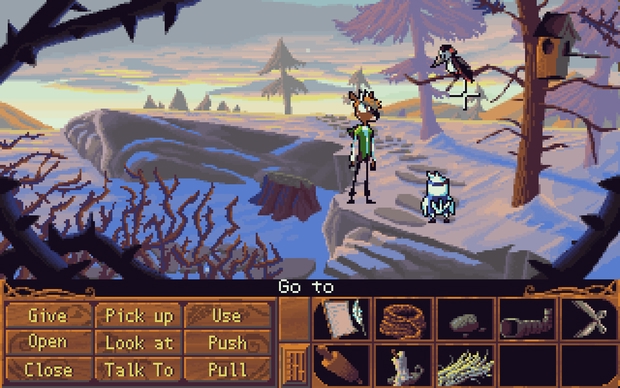Beyond The Edge of Owlsgard review – A hoot of a pixel art animal adventure

- 0 Comments
Ever since I saw it in a magazine as a kid, I always wanted to play Inherit the Earth, the 1994 point-and-click from New World Computing where you play as a fox and go on a great big magical quest with a bunch of fellow woodland creatures. Alas, it never found its way into my childhood home, and so those youthful dreams went unfulfilled. I’ve considered purchasing it and giving it a go as an adult, but for one reason or another I’ve never gotten around to doing so. The reason I bring this up is that even though I’ve pretty much let go of the ambition to play Inherit the Earth, my desire to go on a magical quest with a group of woodland creatures never went away. So I was really excited about Beyond the Edge of Owlsgard, which promises just that, and manages to deliver to a pretty admirable point.
I’m going to let the cat out of the bag right away: Beyond the Edge of Owlsgard (henceforth just Owlsgard) is, when considered as a whole, a great adventure game. It is also, perhaps because of its frequent instances of greatness, a very frustrating one. There were moments – and many of them! – when I was ready to proclaim this one of the best point-and-clickers I’ve ever played, right up there with Fate of Atlantis, Day of the Tentacle, Gabriel Knight, and all the other usual Top 10 suspects. But then there were also moments when some of the puzzle and narrative design were so flat-out objectively bad that, in a game so full of brilliance, it boggled my mind. We’ll talk about this more in detail, but rest assured, you absolutely should play Owlsgard.
After an ominous introduction in which Once Upon A Time, A Long Time Ago a very important Owlish library burns down (a tree, it turns out, is not the smartest place in which to house a library), we zoom forward to present day. Finn, who is literally a healthy young buck, returns home from a merry frolic to find his parents missing. The small forest cabin of his youth has been forcibly vacated, and the only obvious clue is some very large tracks, which don’t lead far. Determined to rescue his parents, Finn heads into town to ask around and search for clues, and it is here that our Great Big Magical Woodland Creature Quest begins.
One of the first things you’ll notice is how alive and detailed the resplendent pixel art world is. Trees move and you hear the wind blowing. Water flows and you hear the current rush. Birds fly hither and thither and you hear them chirp and twitter. Ambient noises play gracefully with the subtle and always appropriate musical score. The lush audio-visual experience of exploring Owlsgard is embellished to a rare level, and I was immediately swept away. Spend a little more time with the game and you might notice that its style is more than just an imitation of 90s adventure games, it is a loving homage to the animated films of that era as well.

The quality of the animation and sheer panache of the cutscene direction brought me right back to that time when adventure game developers were referring to their creations as ‘interactive Disney movies,’ and only a few of those ever felt as cinematic as Owlsgard does. (The closest I can think of would be Full Throttle.) Little animations like a tall wolf bending down to get under a door frame built for smaller animals, or a French mole making his exit by diving headfirst into the ground and burrowing away, are unexpected, beautiful, and funny. Owlsgard also goes places that Disney never would, with the occasional non-gory but still very flinch-worthy violent death and deep dark plot elements, and it’s better for it.
After leaving Finn’s wrecked homestead, you’ll visit the nearby town. Travel between locations is done by clicking on an overworld map. The map looks great, and the game does a good job of highlighting new areas as they become accessible. The town is hustling and bustling, with anthropomorphs of all kinds zipping and slinking around as they go about their days. In speaking with the diverse crowd of citizens in the town square and local pub, it becomes apparent that Finn’s parents are only one of many recent abductions. Most folks believe it’s the work of the wolves, with whom relations have lately been quite bad. A scant few believe that something a little more Twilight Zone-y could be going on.
Trying to gather clues and piece together what all might be happening requires a lot of NPC interrogation. Not all of it is necessary, but since there’s no way of knowing what’s important and what isn’t, your urgent rescue mission is quickly curtailed by a lot of superfluous conversation with the game’s healthy abundance of interactive characters. It’s enjoyable in its own right, but it slows down the entire first half of the game, and it isn’t helped by the unbalanced feel of Owlsgard’s dialogue.

The voice acting cannot be blamed; it’s excellent. Sometimes over the top, yes, but it made me smile and think of the old Sierra days when trained skill was not as important as unbridled enthusiasm. In all seriousness, the acting in Owlsgard is much better than most games from the era that inspired it, and although there is an owl, there are no Cedrics.
The awkwardness of the dialogue, therefore, must be blamed on the befuddlingly inconsistent script. There are times when the humor is delivered spot-on, the prose is touching, the exposition is compelling, and the wit is impressively clever. And then there are times when it seems like developer WatchDaToast fired his English translation team after they’d submitted their first draft. After a while, it became a bit of a game to spot the typo (whole instead of hole), botched translation (‘what a nonsense’), out-of-character colloquialism (‘not gonna lie’), and anachronistic references to things like R-rated movies and mosh pits. Maybe it’s because I grew up with a mom who is an editor, but these moments, so ill-fitting with the rest of Owlsgard’s world-building motif, caused me to wince. In either a lesser game or one with less focus on interrogation, this qualitative dissonance might barely be noticeable. In a game that comes so close to being an all-timer, it is worth mentioning.
On a less granular scale, though, the storytelling is incredible. Just when you are comfortably settling into the well-told but tropey Find the Missing Parents quest, the game throws you a curveball and hugely expands the scope of your adventure. Then, just when you think things can’t get any bigger and better, bam! another massive, exciting, and unpredictable twist that escalates the stakes in such a way that it’s hard to imagine you ever came from where you started, in that opening scene outside of a little beaten-up house in the woods.
Similar tale-weaving kudos are owed to the dramatic yet believable relationships between several of Owlsgard’s important characters. The friendships between Finn and his companions are organically grown. Trust is realistically earned. Enemies are not Bad Guys, they are people (well, animals) who have believable and understandable reasons for behaving the way they do, and although I had suspicions, I didn’t know for sure until late in the game which of Finn’s antagonists would end up being friend or foe or dead or alive by the time the story wrapped up. The relationship between the wolf chief and his daughter Jarlena is particularly compelling. I would love to play this game in its original German, since it seems clear that most of the failures in Owlsgard’s narrative are due to losses in translation, not lack of skill.

The puzzles are another story (no pun intended). Once again, there is a severe and frustrating imbalance. There’s a scene midway through the game that involves two dolls that appear identical, but there is a subtle difference between them. You must find it, on penalty of death if you don’t. This scene is so unexpected, so clever, so tense, and so well done that I immediately wanted to call all of my adventure-playing friends and tell them how great it is. While that was, for me, the apex moment of Owlsgard, the rest of the game is chock-full of top-quality puzzle design too. I’d call it top-quality old-school puzzle design, but frankly, there weren’t even too many games of the old school that did it this well – only the very best of ’em.
For me, the best adventure games fill me with confidence not to give up even when I’ve been stuck for a while: just look harder, think a little more, and I’ll figure it out. It’s a very good feeling, and Owlsgard made me feel it. There are no logic puzzles in this game, but there are some really hard ones based on observation, environmental interaction, and inventory where if you’re not paying attention, you’re not going to figure them out. The best way to describe the majority of these puzzles would be ‘challenging but fair.’ There is no hint system or hotspot indicator, although there were only one or two instances where I thought the words ‘pixel hunt’ might be applicable.
Unfortunately, there are a small but substantial number of puzzles that would not be very challenging if they weren’t also unfair. Doors are not at a premium in Owlsgard’s universe. From start to finish, you’ll probably open and close a couple dozen of them a couple hundred times. You can usually accomplish these opening and closing actions in one of three ways: (1) right-click on the door, (2) select the ‘Use’ verb from your SCUMM-style nine-verb menu and click on the door, or (3) select the ‘Open’ or ‘Close’ verb and click on the door. Pretty standard quality-of-life leniency in adventure games. However, there are a couple of instances later in the game where one must specifically use the ‘Close’ verb on certain doors to progress. I wandered for hours, reduced to backtracking as far as possible and trying everything on everything, until I gave in and looked at a walkthrough. And I’m glad I did, because otherwise you might be reading this review a month from now.
There is also a proliferation of rocks littering the world. You can look at and try to interact with most of them and receive the same responses. Except for one of them. There is one rock that contains something crucial to solving a multi-layered puzzle. Your instinct will be to try getting this crucial thing from one of the rocks. Maybe you’ll even try two or three or four different rocks before giving up on rocks altogether. Here’s a helpful piece of advice: don’t. Puzzles like this aren’t puzzles. They’re artificial ways of changing the rules of the game to put the player at a disadvantage.
I’m also a little confused as to why WatchDaToast included a puzzle that involves stuffing a mattress down your pants, when a more elegant and credible solution could have been integrated into the scenario just as easily. Either way, congratulations, Mr. Toast: you’re a definite contender in the ongoing Biggest Thing an Adventure Game Protagonist Stuffed Into Their Pants or Jacket contest.
I should note that Owlsgard gives players the option of choosing between Classic Mode and Modern Mode. In Modern Mode, hidden items are more obvious (so no pixel hunting) and timed puzzles are more forgiving. This review is based solely on my experience playing Classic Mode. Finding all the necessary hotspots was generally not a problem, and I never had any issues with the timed puzzles. There’s one timed puzzle in the second half of the game that will require a few tries, but it’s more a matter of knowing what to do than having the dexterity to do it.
Many of the flaws I’ve mentioned surface in the game’s lengthy final chapter. Up until that point, most of my complaints would have been minor nitpicks and I’d be declaring Owlsgard my 2023 Game of the Year in the middle of January (even though it technically released a few days before the end of 2022) – that’s how good the good stuff is. Even when the first three chapters are slowed by the constant and repetitive nature of the conversations between Finn and the splendidly diverse set of critters, meeting all those characters and laughing at their clever idiosyncrasies (a Queen Magpie taking a Scrooge McDuck-style coin bath? Brilliant! Legendary Sponge Sheep soaking up an entire ocean? Not baaaaaaaaaad, either!) gives the game vibrancy and a unique spark, differentiating it from so many of its point-and-click peers. Chapter 4, by comparison, is extremely sparse and bleak, and unfortunately it’s a doozy. The last quarter of the game is still by and large enjoyable, but it’s a steep plummet from the peaks upon which its preceding parts reside.
Final Verdict
Can I use the word ‘brilliant’ again? Owlsgard is brilliant. How about ‘frustrating?’ Owlsgard is that, too. Not so much because some of the instances of poor puzzle design frustrated my progress unfairly (which they did), but because they dim the shine of what is an otherwise stupendously entertaining adventure game experience. I so badly want to lavish Owlsgard with nothing but glowing accolades – so high are the highs and so much fun I had playing it – but I can’t, and that frustrates me. Yet even with its periodic aggravations, Beyond the Edge of Owlsgard is one of the best adventure games in recent memory, and every point-and-click fan should absolutely play it.
Hot take
Beyond the Edge of Owlsgard might be the best point-and-click adventure game about animals ever made. And with a little more playtesting, the ‘about animals’ qualifier might not even have been necessary.
Pros
- Unpredictable and exceptionally well-told story
- Critterful cast of characters is fun and refreshing
- Exciting cinematic cutscenes
- Lushly detailed and animated world
- An abundance of exceptionally well-designed puzzles
Cons
- A few puzzles are unfair
- Too much interrogation of fellow woodland creatures slows down the early sections
- Final chapter not quite as excellent as the three that precede it
Michael played Beyond the Edge of Owlsgard on PC using a review code provided by the game's publisher.

- Advertisement
- Help support AGH by advertising with us











0 Comments
Want to join the discussion? Leave a comment as guest, sign in or register.
Leave a comment